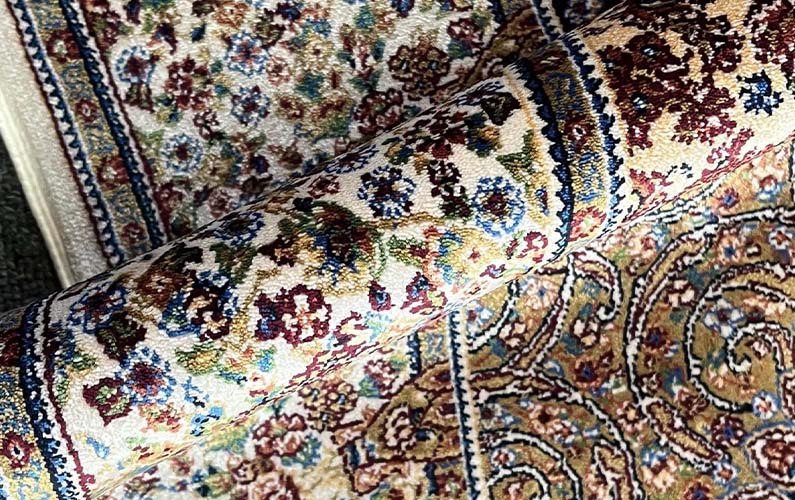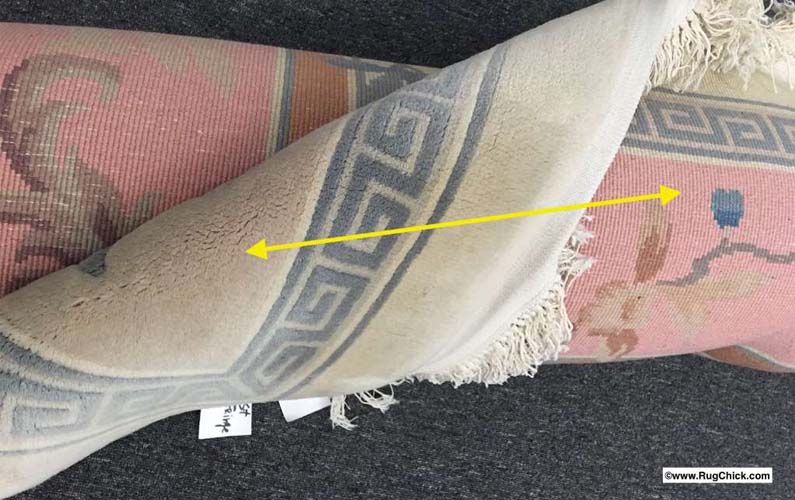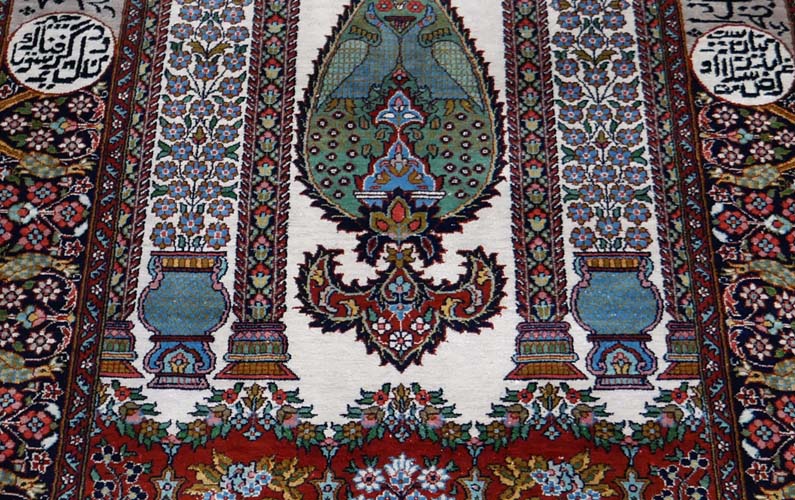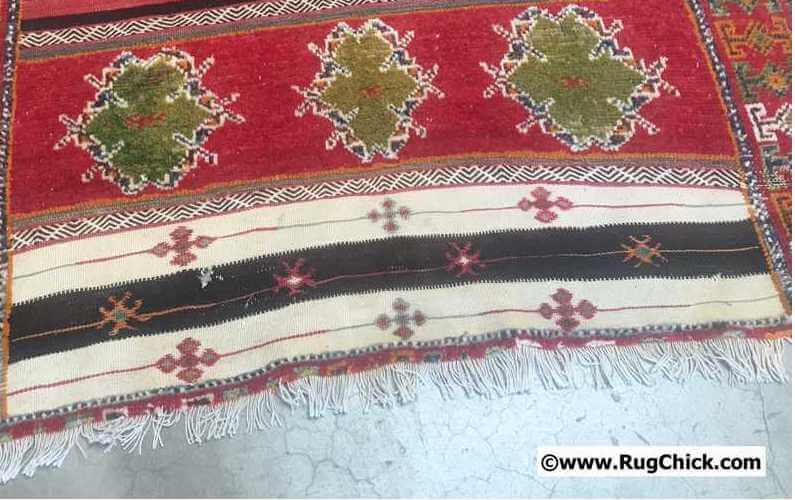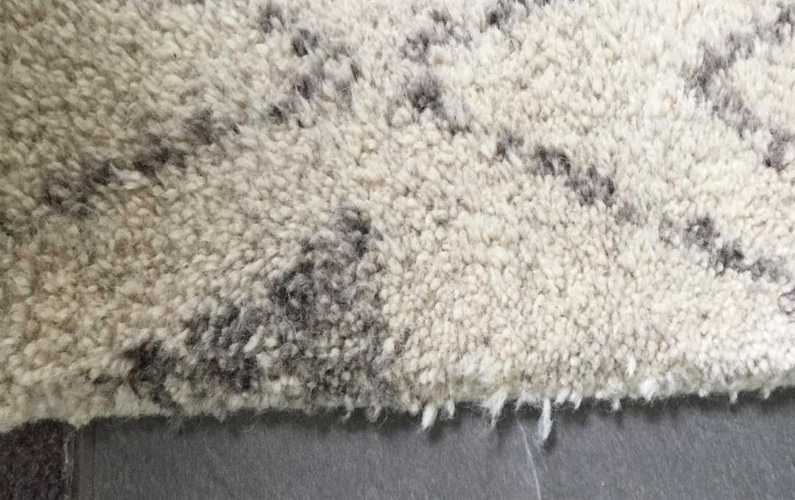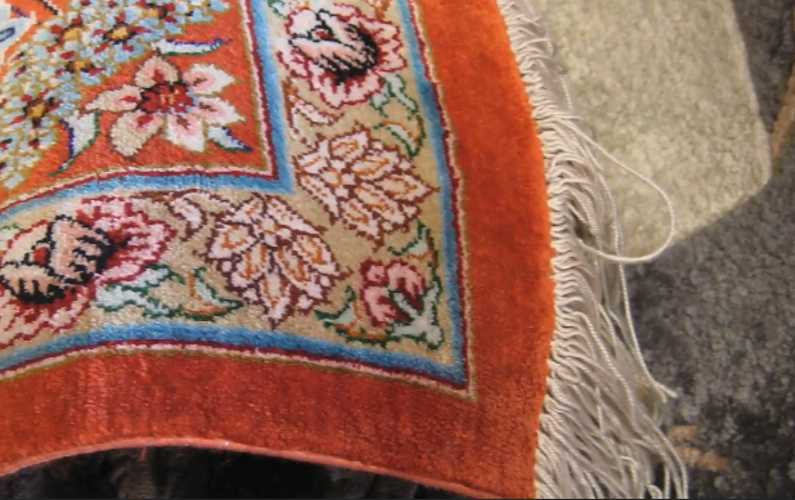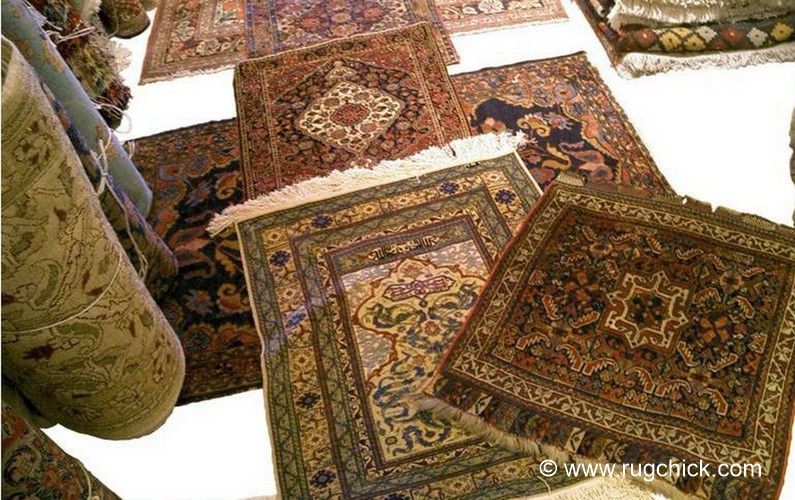Rug Fringe. What You Need To Know
Fringe. People love it. Or they hate it.
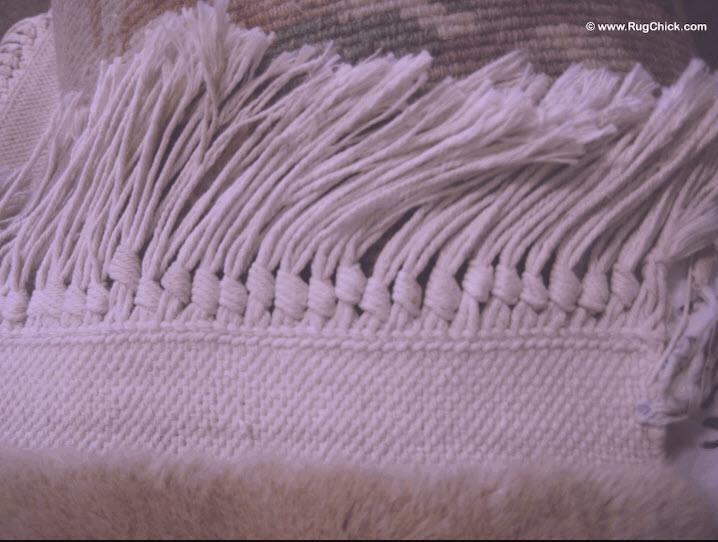
Bright white BIG fringe!
On some rugs, it’s short, so it’s not a bother.
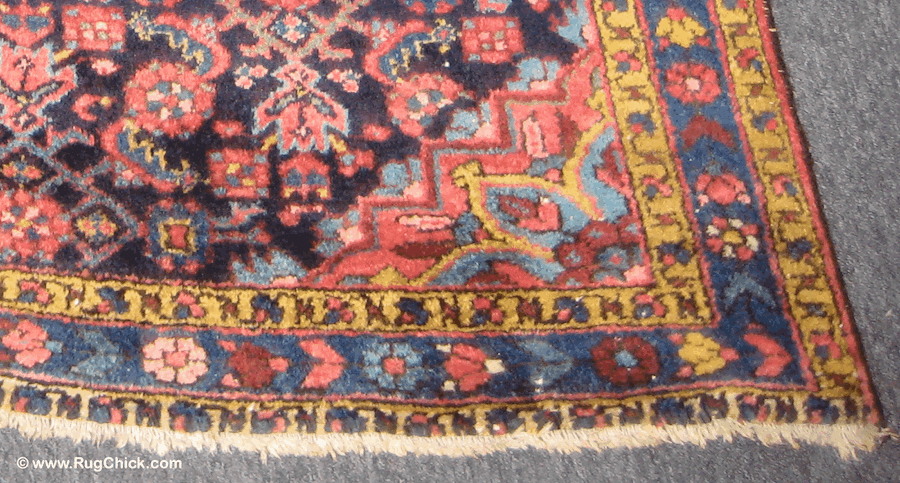
Older rugs tend to have short fringe because it’s worn off.
On others it’s L-O-N-G, and drives some rug owners nuts. (I’ve had more than one take scissors to them in frustration… and then discovered the costly error of their ways, which we will get to later in this blog. Just HIDE the scissors for now please.)
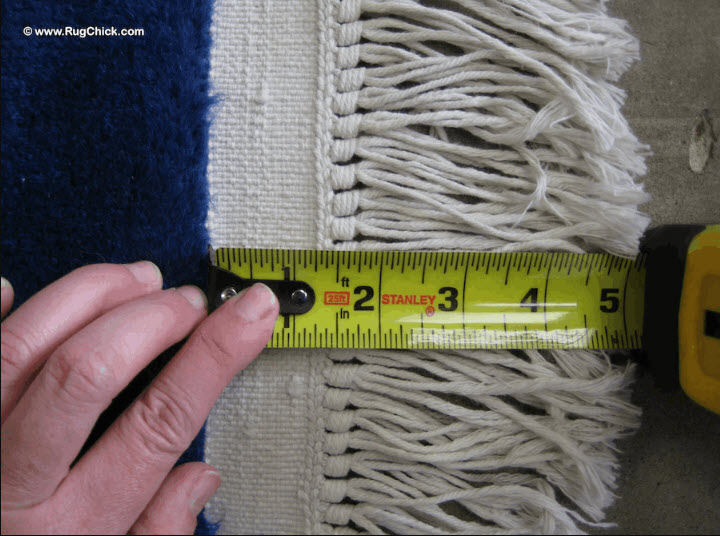
And for rug cleaners, fringe is the part of the rug they hate the most.
It’s the part that gets the filthiest, requires the most labor to clean, and makes a rug owner not happy with the cleaning job if it’s not perfectly white.
So let’s talk about fringe. What you need to know about those tassels, and the solutions to the most common fringe frustrations.
WHAT IS FRINGE?
On hand woven rugs, the fringe tassels are the WARPS of the rug. These are the strands that wool (or silk) pile knots are twisted and tied around to create that rug.
This means each single tassel strand (usually cotton) runs from one end all the way through the middle of the rug to the opposite side. It is the skeleton of that rug.
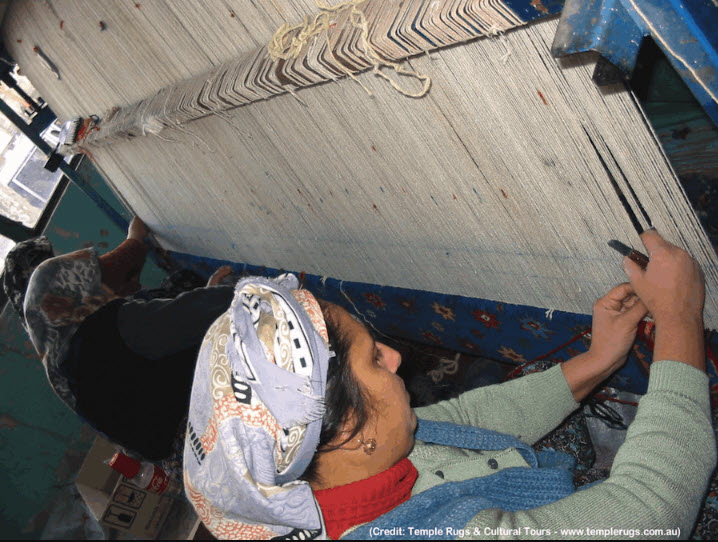
Cotton warps strung on a Turkish loom are what the wool knots are tied around. The warps will end up as the cotton fringe tassels of this rug.
Fringe in most cases has little or no significant impact on the value of a rug, because it is a byproduct of the weaving process. But if the fringe tassels untie, are torn, or wear off, the knots of the rug can begin to pull away and unravel, and this ABSOLUTELY has an impact on the value of the rug.
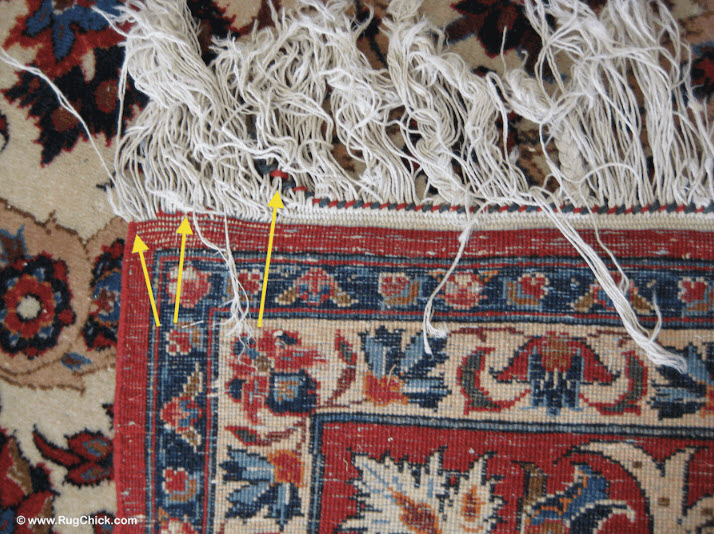
The decorative braid is sliding away from this Persian rug, the fringe is unraveling and wool knots are sliding away from the rug. This impacts the value if it continues to lose knots from the outer borders of the design..
If the rug is a machine woven rug, then the fringe will be added on after the fact, usually machine sewed on or glued on. So when the fringe on these rugs gets filthy, or damaged, it’s an easy choice – tear off the old and add on some new.
With hand woven rugs, where the fringe tassels are the foundation that the rug knots are tied around, it’s not that easy. Fringe that gets torn by the vacuum cleaner, chewed off by the dog, or worn off from foot traffic, needs to be handled right away… and in the right way.
What does the owner of a “real” woven rug do when their fringe gets filthy and damaged?
Here are your options.
CLEAN THEM
Most rugs today are woven on a cotton foundation. This is usually the part of the rug that spurs someone to get their rug cleaned, because it begins to look dingy on the fringe.
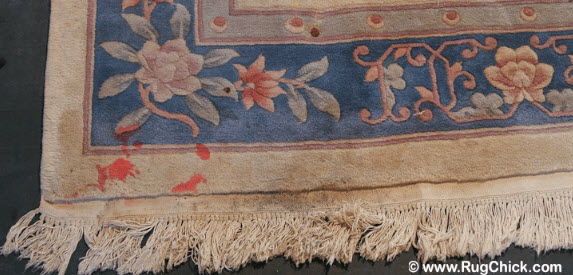
Filthy fringe. What are the realistic expectations?
Wool is the best fiber for use in a rug because it “hides” dirt amazingly well. The fibers have layers of cuticles to hide dust and grit, and as it gets dirty it just begins to look dull.
But the COTTON is another story. Cotton has no place to hide soil, so it gets embedded, and ground into the strands.
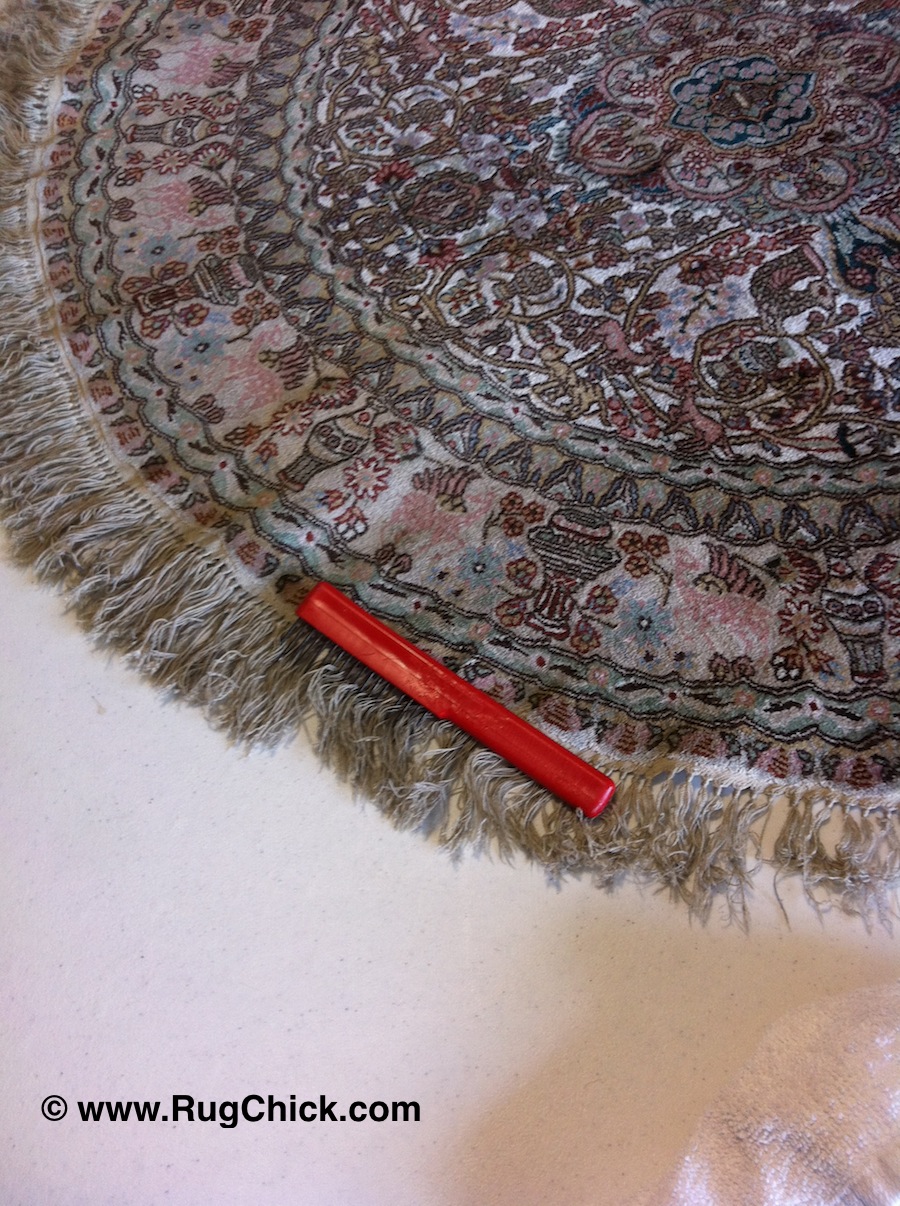
Filthy fringe. What is a rug cleaner to do?
I liken cleaning cotton fringe tassels to trying to clean heavily soiled shoelaces. There is no way to just spray on a solution that magically makes the soil disappear. You have to scrub, and scrub, and scrub it clean.
If a rug begins with super white fringe when it’s new, this means that fringe was strongly bleached white BEFORE it went to market for sale.
This whitening process makes the fringe look great at that time, but it comes at a cost. Bleaches and oxidizers (like hydrogen peroxide) do create chemical damage to the cotton fibers to create that “white” look, and it weakens them.
That damage may be slight, or may be severe, based on the strength of the solution – and whether there was already past damage that this is deteriorating even further.
When you have cotton fringes that easily break off when you tug a strand, this is a BIG warning sign of past chemical use.
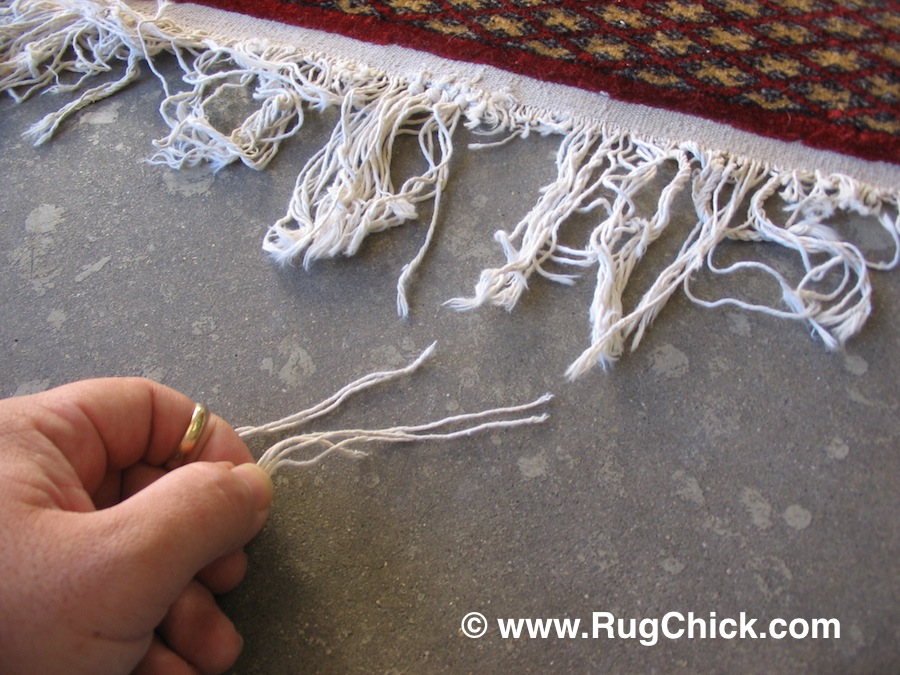
These tassels tear away with a gentle tug. That is a sure sign of deteriorated fringe. You cannot reverse this damage.
If tassels are tearing away when they are walked on, this is also a sign of either very old/worn fringe, or chemically damaged fringe.
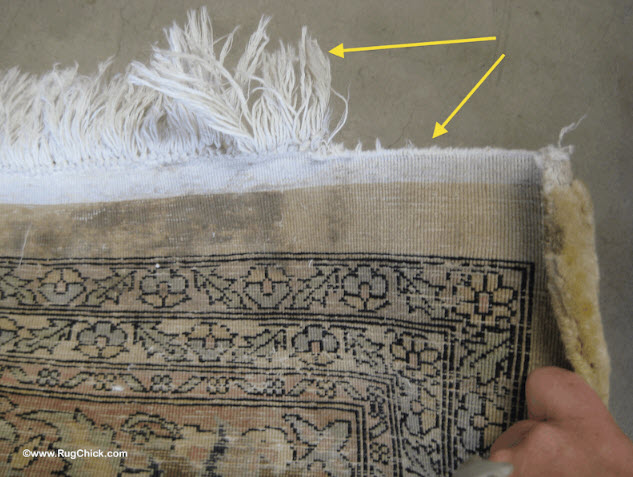
Severe fringe damage. This cotton is rotten from past bleaching and the tassels have torn away as a result.
The problem for rug cleaners when they are given fringe in this condition is they can’t really scrub them without the fibers breaking.
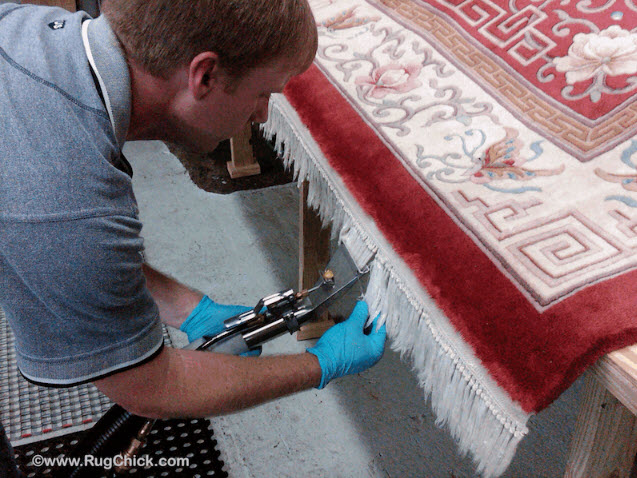
Even the gentlest of cleaning methods can be too much for already damaged cotton fringe.
Even with a gentle cleaning, fibers are going to break off, and you will not get those fringes looking fantastic without a thorough scrubbing. They cannot expect their rug cleaner to get that fringe clean when it is too fragile to do the job right.
So rug owners with this type of damage to their fringe may need to look at the other options to help clean up the look of worn/torn/weak fringe, while also ensuring that the base of those tassels do not tear away and result in their rug unraveling and coming apart.
Here are some options for your “Fringe Frustrations” when cleaning just is not enough:
FRINGE: CUT THEM SHORTER!
When fringe tassels are extremely long, sometimes they can simply be trimmed shorter to be less “in the way.” This makes them less likely to be grabbed by a vacuum cleaner, or snagged by shoes.
The problem with just cutting them as short as possible is that when these tassels are the warp foundation threads of the rug, this will lead to unraveling of the rug knots – and the loss of value. You want to cut them shorter, but not too short.
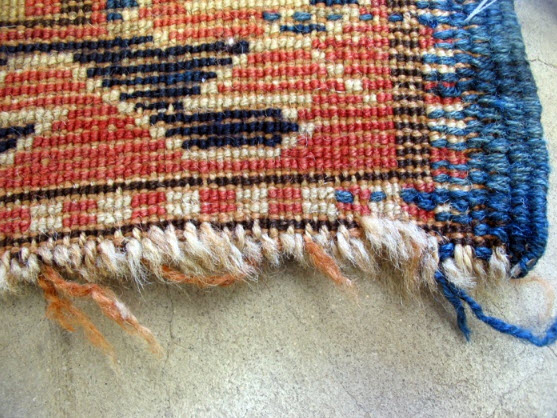
This fringe was cut shorter by the client, but the knots of the rug are now sliding away.
If the fringe is KNOTTED, this tying off helps to hold the end of the rug together. When you cut the tassel strands shorter, do not cut them so short that the fringe knots untie.
Sometimes, it is the fringe tassel knots that are the problem. Because the knots can be higher than the rest of the tassels, shoes can press and pull at these knotted points and the cotton fringe (if it is weakened from past chemical whitening) can literally tear off at those knots, and then the rug unravels.

Some of the tassels have torn at the knots. This can happen with high traffic on rugs with knotted fringe.
A frequent repair when torn knotted fringe is the problem, is for our shop to untie the fringe, secure the end by hand (with an overcast, or “end stop,” stitch), and then trim the tassels shorter. This removes the problem of fringe tassel knots being torn away.
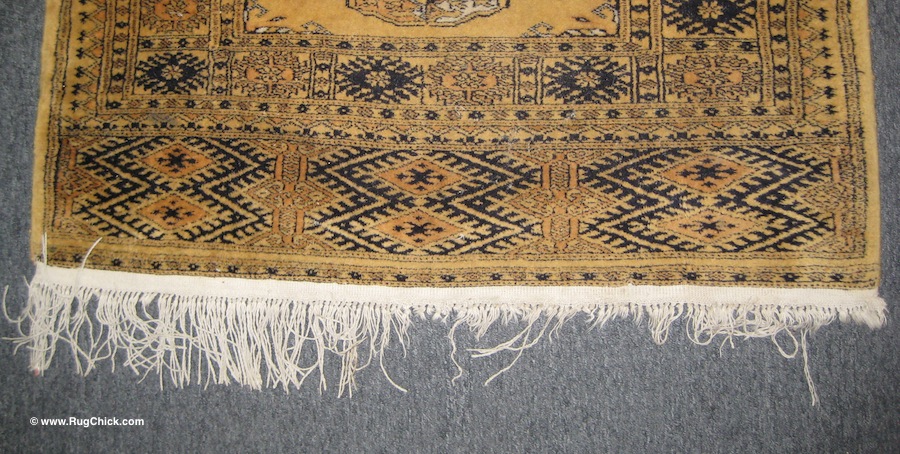
Fringe has torn at the knotted cotton tassel points due to foot traffic. Sometimes it is better to have unknotted fringe on rugs with foot traffic.
If the tassels are unknotted to begin with, the same step applies. Make sure the end is secured by a rug repair specialist, and then trim the fringe appropriately. If this type of repair (overcast or endstop) is done properly, it should not have to be done again. In our rug shop we guarantee our end overcast work for the life of the rug, because once it is done properly, it should be anchored in for life.
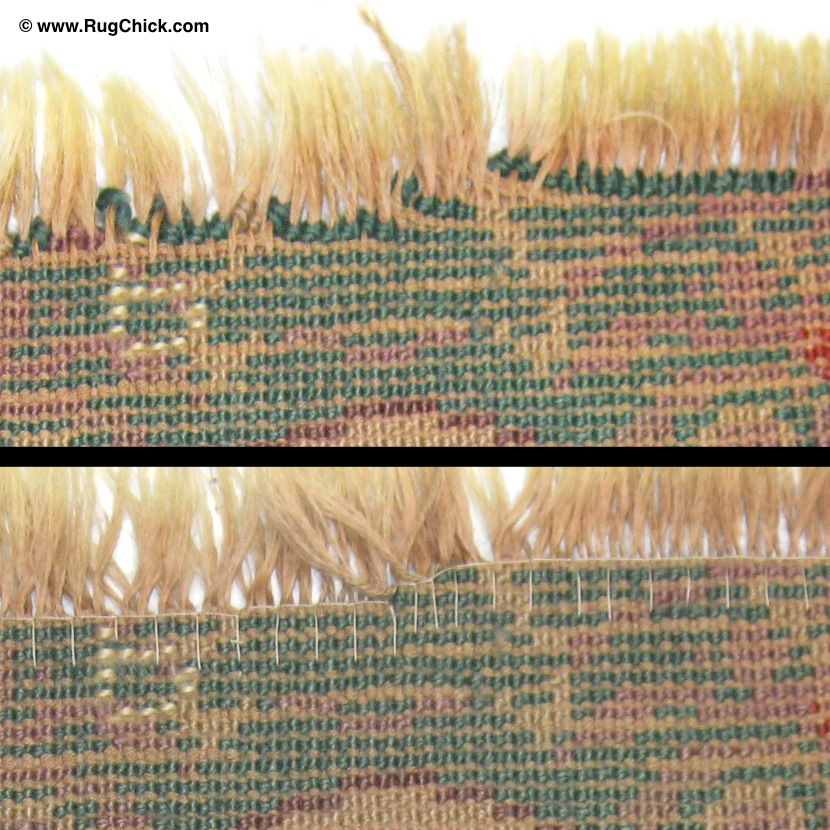
Unraveling rug is secured using an end overcast stitch. The common stitch is a button hole stitch, and on this piece it is angled to try to save as much of the original knots as possible. View of the BACK side of the rug. Securing stitch to prevent unraveling of a hand-knotted rug is visible on the back side but not on the front.”
Unraveling rug is secured using an end overcast stitch. The common stitch is a button hole stitch, and on this piece it is angled to try to save as much of the original knots as possible.
A poorly executed overcast/endstop (usually by someone who saw the stitch in a book but never went to a weaving workshop to learn it) can end up creating more damage than the original damage. The bad approach is to anchor those stitches to the same common weft thread (the foundation threads running the width of a rug are the WEFTS), and this repeated stitching to the same weft can pull away the end of the rug and result in the loss of several rows of knots.
A proper stitch will have at least every few stitches anchored to different wefts to avoid that problem.
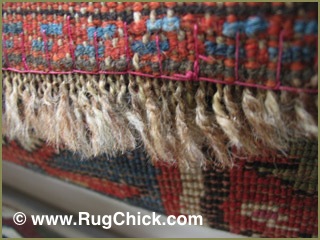
Strong end overcast stitch with varying stitch lengths every few stitches to allow for a long lasting result.
The purpose in all of these cases is to make the fringe “look” better, but most importantly to protect the integrity of the weave to prevent it from unraveling.
FRINGE: HIDE THEM!
If you want to remove the risk of fringe being torn away entirely, then you can “hide” the fringe. One way is to first properly secure the end so the rug is in tact, and then to hide those tassels (if they are short) by wrapping the end in the same way the sides are over-wrapped with wool.
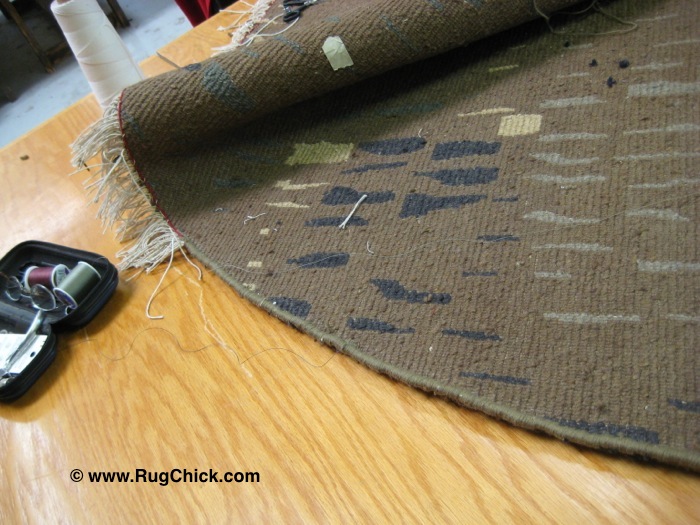
This round rug is owned by someone who does not want fringe. The tassels are shortened and the edges are wrapped in wool to “hide” the tassels.
When rug owners get frustrated with their fringe and take scissors to them, the rug will come apart. By hiding the fringe you get the same look you want but without the structural damage to the rug.
If wrapping the edge is not an option because the tassels are too long, you can also simply fold the tassels behind the rug and cover them with material.
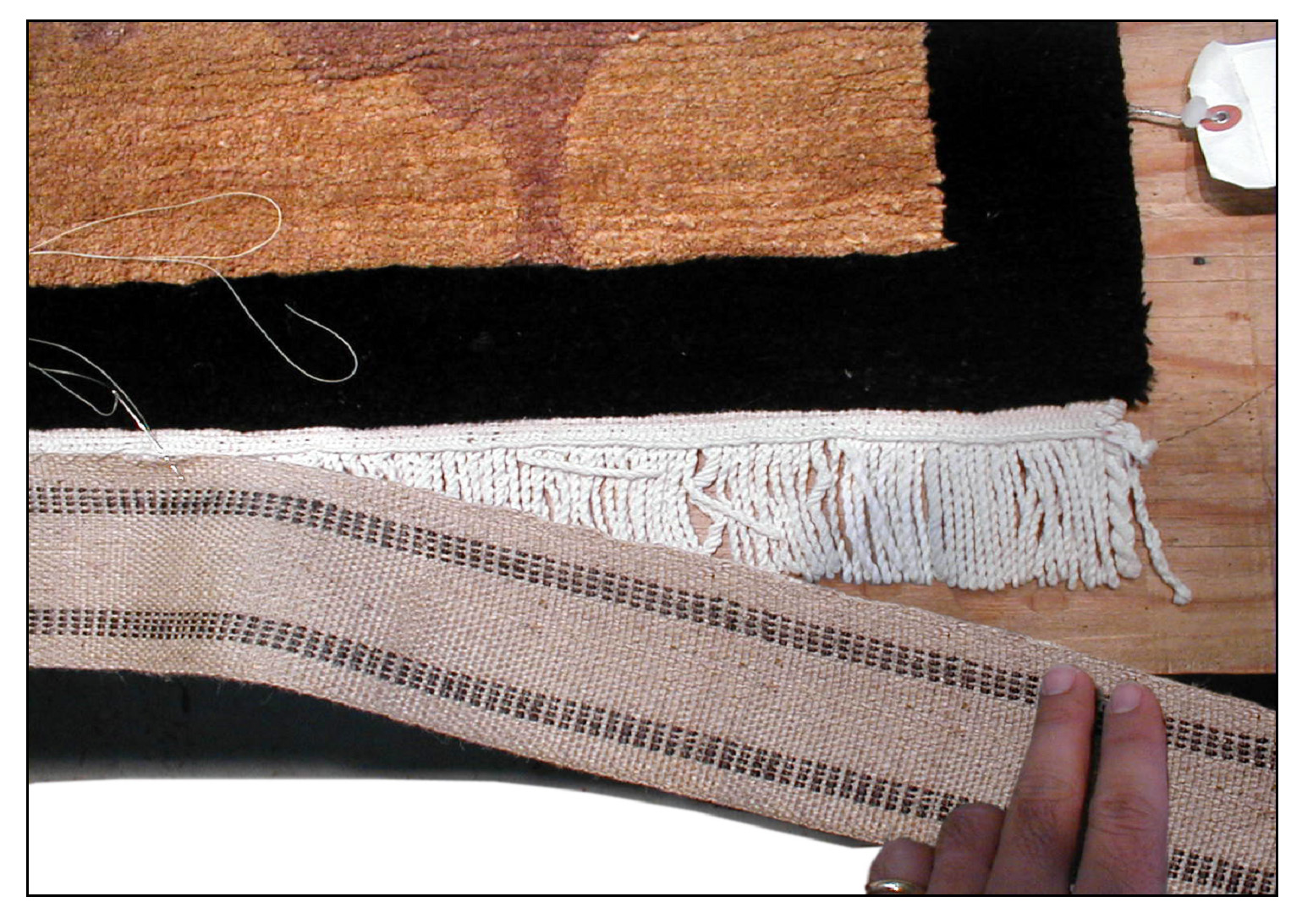
A Tibetan/Nepalese rug is having its fringe hidden. Binding material is placed over the top of it, and it is folded back to hide and protect the fringe UNDER the rug.
This is a solution you see on a number of newer Tibetan/Nepalese rugs. These rugs tend to have fantastic quality wool, in great natural tones or with splashes of color, and sometimes the very white fringe just does not frame it quite right so some retailers have the fringe hidden with material. This keeps the rug entirely in tact, but gives consumers the look they want.
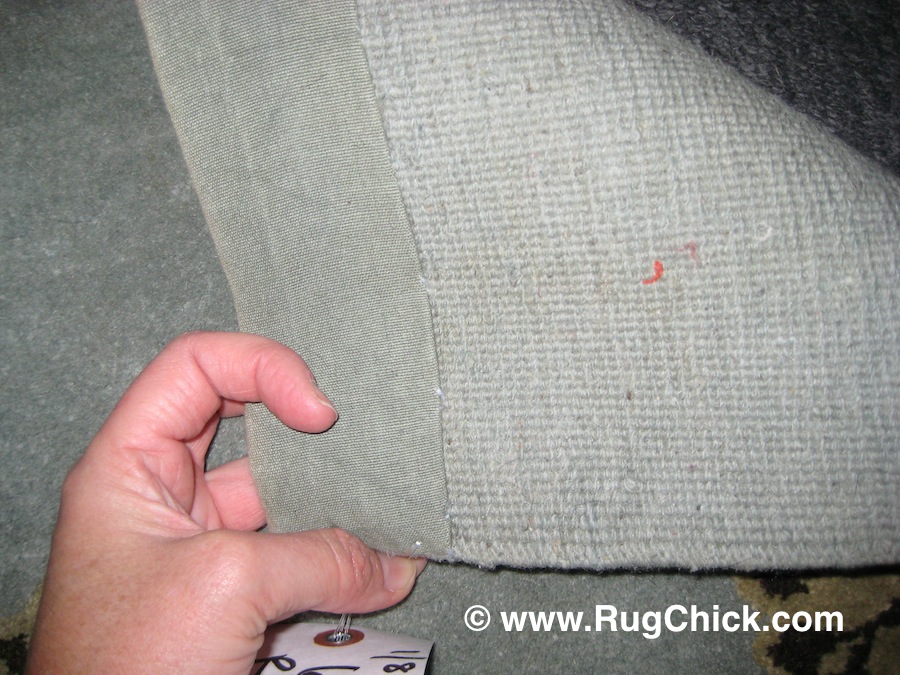
Another rug with hidden fringe.
The “poor man’s” version of hiding fringe is often done by taping the fringe to the back side of the rug. If you choose this option I would recommend you use masking tape because it leaves much less adhesive residue than clear packing tape or other options. Just be careful because when you remove stronger tape from whitened/weakened fringe, you will be tearing away the tassels you were trying to protect.

Clear packing tape was used to hide/protect this Nain rug’s fringe, but pulling the tape off in order to wash the rug resulted in it losing many tassels because the fringe had been weakened by past chemical whitening in Iran.
FRINGE: REPLACE THEM!
Most of my peers who “know” rugs hate fake fringe. And I believe that is because most rugs that have had new prefabricated fringe put on them have been done using surging or sewing machines, and this ALWAYS creates damage to a hand woven rug.
Hand woven rugs must always be repaired by hand, not machine. Because a skilled hand can slide needles AROUND warps and wefts, causing no foundation damage, while a sewing machine will repetitively power THROUGH warps and wefts with no mercy.
Here is a beautiful Senneh rug that has been massacred by a surging machine, sewing on prefabricated side-cords and prefabricated fringe.
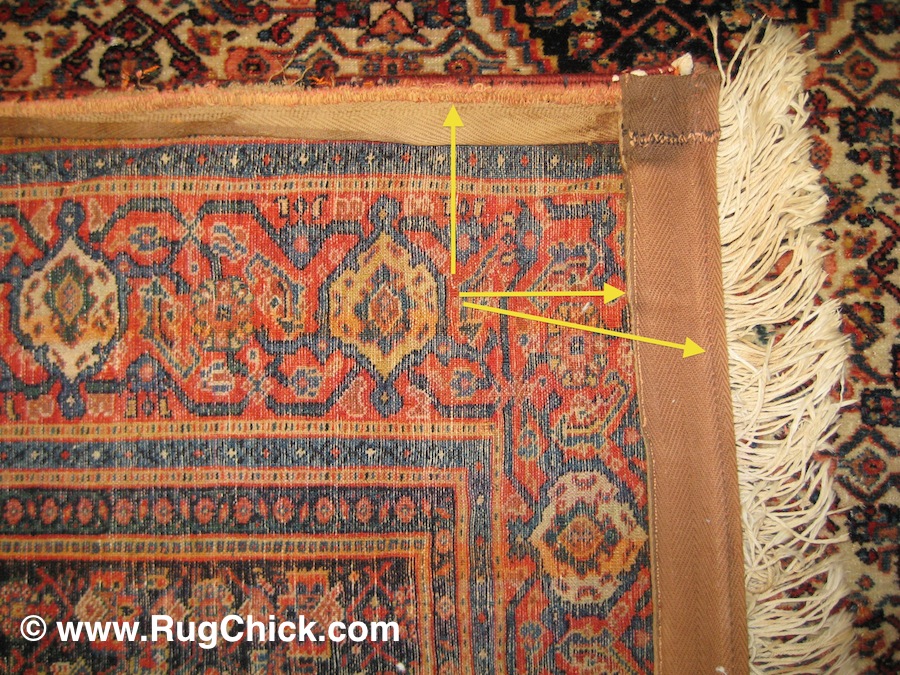
Senneh rug that has been attacked by a sewing machine to add side-cords and fake fringe. This machine work always devalues collectible rugs.
To the untrained eye this type of work may look perfectly fine. But the skilled eye will recognize that eventually this rug will tear along the sides and ends exactly where those machine stitch lines are. That type of work “perforates” the rug and makes it tear away.
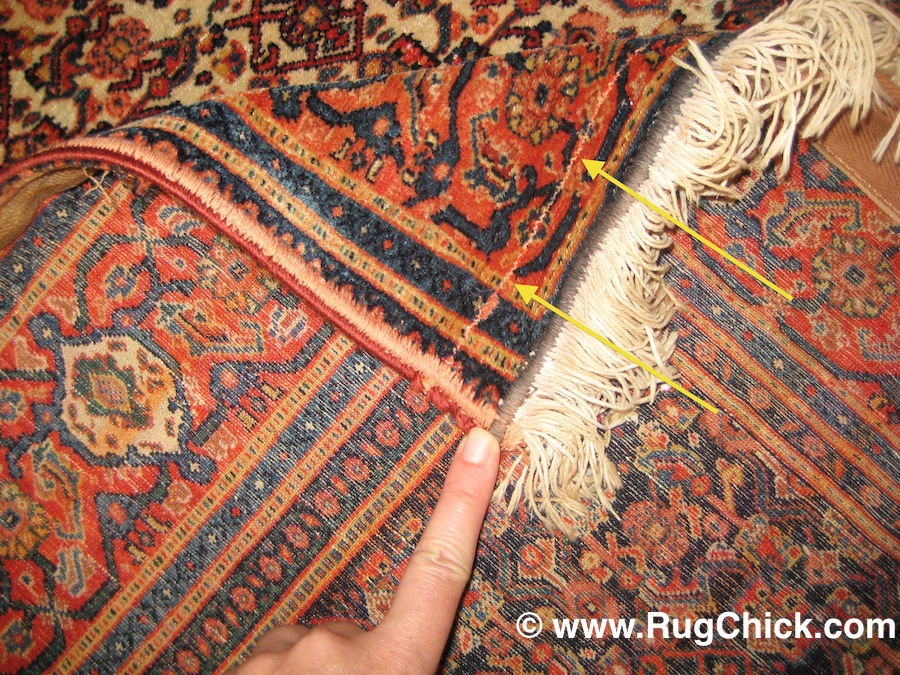
This rug will eventually tear away at the point where the arrows show the innermost stitching from the sewing machine.
This type of damage impacts the value of this rug, because it cannot be undone. Even if you took off the machine stitching along both sides and ends, which would take countless hours to do, the damage is done. Those wefts and warps are already torn.
Companies who do this type of machine work to hand woven rugs need to be driven out of business, in my opinion.
This is the same type of operation that would grab duct tape or glue to “fix” holes or unraveling rugs. Their work makes the problem worse, and destroys pieces of textile art in the process.
So, regarding “fake fringe” – I am NOT referring to the fringe that is applied by machine. We are talking about prefabricated fringe, which comes in many styles and colors, and is applied to the rug BY HAND.
Why I like this as an option is because true restoration of the fringe tassels can be costly, and sometimes can create more damage than good in the quest to make those fringes look as if they were never damaged.
Trying to anchor in new warps several inches into the base of a rug to try to tie new, undamaged, tassels creates strain on the structure of that rug.
Think about it… you have a rug that is tightly woven knots wrapped around a certain number of warps, and you are going to try to shove in and insert MORE warps into the middle of that rug in order to try to make that rug look undamaged.
If you ever see a rug that has had that type of “restoration,” you can FEEL the work. Of course you do, because it’s stiffer along the ends because it now has DOUBLE the foundation threads along the end than it had before.
I personally believe that causes more harm than good over time. I’d rather see you cover up the old fringe with a prefabricated one, and keep the integrity of the original weave in tact.
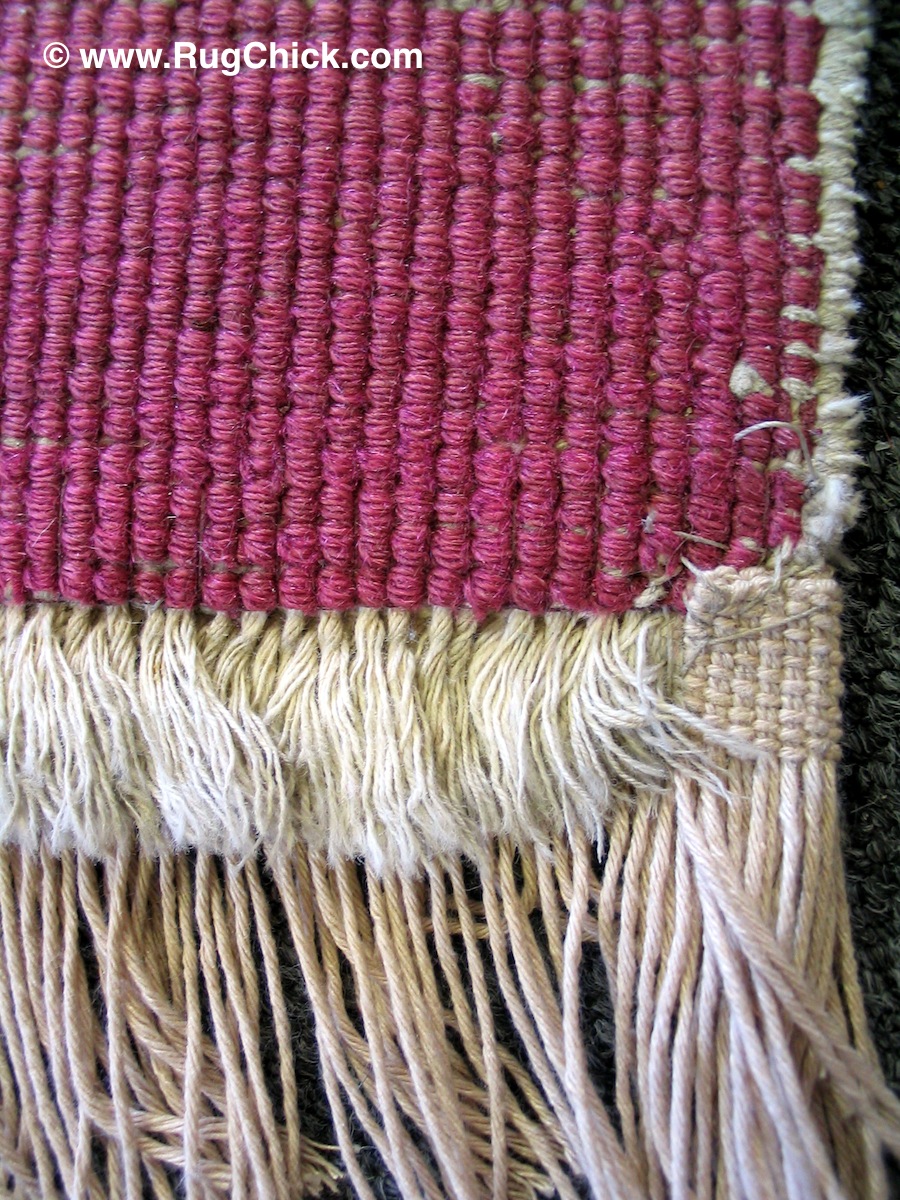
Yes, it is fake fringe, but the original white tassels are torn/worn away, and the beige looked much more attractive. It protects the original tassels from future foot traffic and made it much more attractive with the new color. What’s the harm in that? =)
A prefabricated fringe can be any style or color you want, and it can be threaded and knotted in a way to make it look as natural to the rug as you need it to be.
By being placed on the rug by hand (NOT with glue or a sewing machine), you are causing NO damage to the rug, and you are also covering up and protecting the original fringe that is weak. So you get the “look” of even fringe – if that is what you want – without having to worry about babying it. You can walk freely without worrying about torn tassels anymore.
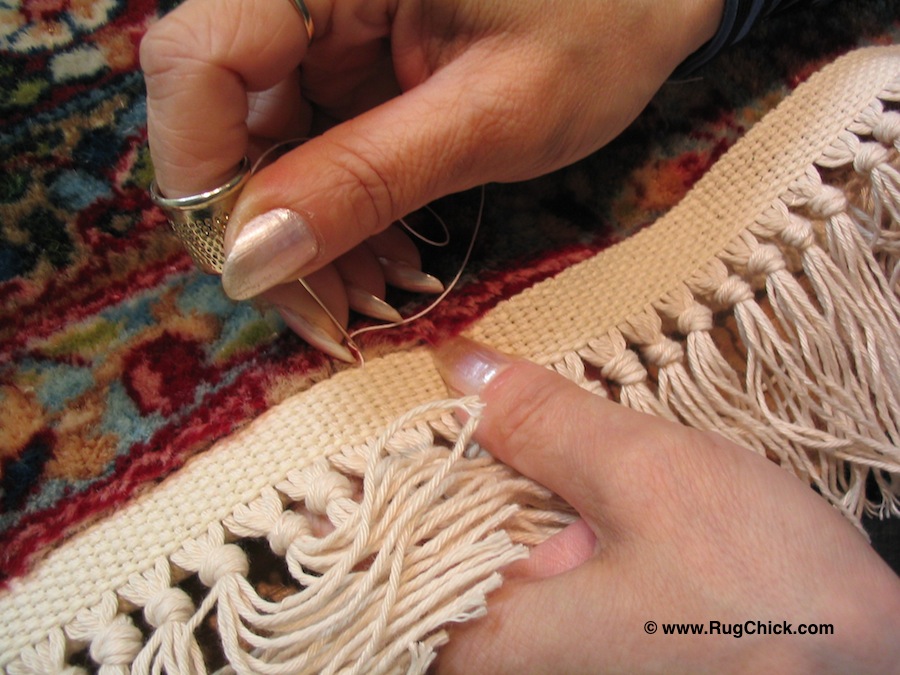
Some rug owners like the look of knotted fringe when theirs has worn away. This gives them the look they want, and protects the original, and is much more affordable then trying to reweave the tassels.
And when it gets dirty – it’s easy to remove and replace, if need be.
If prefab is not your choice, then it is possible (usually at 2 or 3 times the linear foot cost) to restring the tassels. Many companies will do this by anchoring those tassel strands into a proper overcast stitch – this way they are not causing damage to the foundation of the rug.
However, this can sometimes lead to more damage than good, as in this photo of a repair I was observing at a large rug facility.
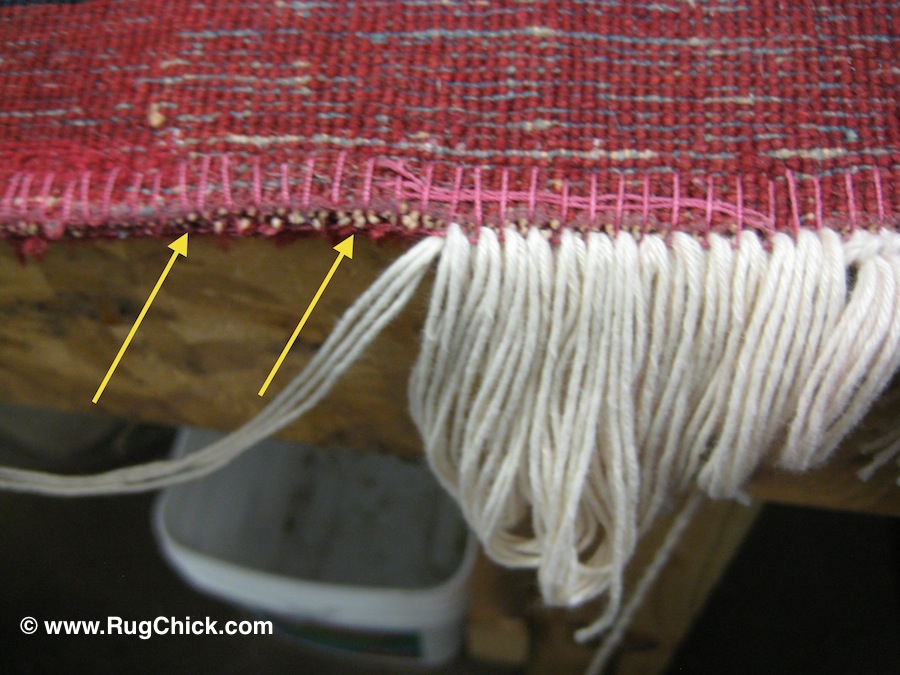
The arrows note where the original warps have been cut off to nothing. This end-stop stitch is NOT going to hold over time. Once it slips loose in one area, it will pull away the wool knots it was meant to protect. It looks good, but it’s a bad repair.
Though the tassel strands being added looked perfect, can you see how short the original warps were cut off. They are barely under that overcast stitching.
This is being done to “hide” the fact that the original fringe was being cut off, but what will happen once this rug is placed on the floor is that overcast stitch will NOT hold. It will slide and lose its tension because there are no warps to hold it in place.
A proper overcast needs at least a good ½ inch of warp strands to hold it in place if it is to last a lifetime.
Why would they put so much time into this level of repair and not do it so it is structurally sound? Usually it is to hide that there has been damage and a repair necessary, so that they can sell the rug at a higher price as “undamaged.”
There are two schools of thought on repairs – those who repair to “hide” damage in order to get higher prices on rugs for sale to uneducated consumers, and those who repair in order to make the rugs as sound as possible so they can be enjoyed for decades to come.
But that discussion about repairs will need to happen another time.
And with that, we will end this post on what you need to know about “fringe.”
I hope it gives you a clearer picture of what to do when you are experiencing any fringe frustrations with your rugs. If you are a rug owner looking for a local rug cleaning company to use and having trouble finding one, then some of the rug cleaners I know – and would use – can be found on my FIND A RUG CLEANER tab at the top of the website.
(By the way, I am still in the process of uploading company details on that page because I know MANY cleaners. If you do not see one in your area feel free to email me for a referral from my printed directory I have in my office, pop to the CONTACT form on the rug cleaner directory site to reach me.)
Happy Rug Cleaning!
Lisa
P.S. Those of you who are professional rug cleaners, my next online rug cleaning course opens up this week for enrollment. Find the details over on the RUG TRAINING TAB. I also have posted a free, short webinar on some of the most common Rug Disasters over there if you would like some more free educational tips on rug care.
P.P.S. Those of you shopping for rugs today (I received a TON of email questions about what to look for when buying rugs from readers of the New York Times article on our rug business last week) – here is my post on what to look for when rug shopping Rug Buying Tips For The Nervous Rug Shopper. Enjoy!

